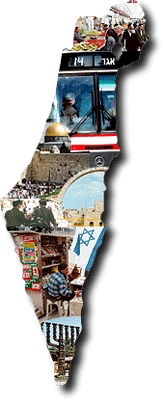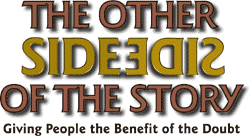Light Lines - Noach
Parshat Noach
6 Cheshvan 5761 / 4 November 2000
Ohr Somayach Home Page
EYES TO SEE
"I will set My covenant between Me and you." (Genesis 17:2)
When we look at the world, most of us see trees, sky, buildings.
The Patriarchs of the Jewish People, however, Abraham, Isaac and Jacob, looked into the world and they saw that one may not wear a garment in which linen and wool were sewn together. They looked into the world and they saw that you may not cook milk and meat together. They even saw that you should wait several hours after eating meat before eating milk.
Maybe I need to change my eyeglass prescription, but I never see such things. I also can't remember seeing in Nature that you can't eat animals which don't have cloven hooves and chew the cud. All I see is trees, sky, buildings.
The Torah is the blueprint of Reality: If one had eyes to see, shatnez, tefillin and keeping kosher would be as visible as trees, the sky and houses.
Abraham had those eyes. He kept the entire Torah -- even the Rabbinic decrees -- long before the Torah was given on Mount Sinai. The entire Torah... with one exception: The mitzvah of brit mila. What is the difference between brit mila and all the other mitzvot?
The word brit means "covenant." The essence of a covenant is that it requires two parties to enter into it together. Until G-d actually made a covenant with Abraham, no covenant existed. Therefore, no mitzvah to perform brit mila existed.
When G-d made the covenant, the brit, with Abraham, He made the sign of the covenant on the part of the body which expresses the essence of a person; the place from which flows the life-force and progeny. Abraham took that essential part of himself which expressed his very continuation; he took the symbol of everything he would ever be through his children's children, and he gave it to G-d.
A brit has to have two sides. There is no pact in the world which consists of only one side. What was it, then, that G-d gave to Abraham? What was the gift of His essence which was to bind Him and the Jewish People to an everlasting pact?
G-d gave Abraham His Will that it would be only the seed of Abraham that would be the agency through which He would conduct and direct the events of the world. The recognition of G-d in the world, His purpose for the whole of Creation, would be brought out through the progeny of Abraham.
|
Ohr Somayach Home Page |
 Selections from classical Torah sources which express the special relationship between the People of Israel and Eretz Yisrael THE PROMISED LAND Four Divine promises to Abraham are mentioned in Parshat Lech Lecha regarding the "Promised Land," and they form a fascinating pattern. As Abraham reaches a higher level in his relationship with G-d, there is a corresponding increase in the level of the promised prize. "I shall give the land to your posterity," (Genesis 12:7) is a limited promise which could mean only a small part of the land which Abraham had traveled until that point -- the site of Shechem. As Abraham's merits increase, he is told to lift his eyes and look in all directions. All those lands would be his, the gift would be an eternal one and his posterity would be as numerous as the dust of the earth. (Genesis 13:14-16) In the historic covenant which previewed the special relationship of Abraham and his posterity with G-d through the sacrificial service in the Sanctuary, the promise is expanded to include the "Greater Land of Israel," and a guarantee that the sins of posterity will not forfeit this promise. (Genesis 15:18-21) In the covenant of circumcision, Abraham's bonding with his Creator is rewarded with a promise that his posterity will return to their promised land even after they are exiled from it, and they will have a special, intimate relationship with G-d. (Genesis 17:8) |
|
Ohr Somayach Home Page |
For spiritual fitness, you sometimes need to assume that others are working on their physical fitness; and remember not to...
Jump Rope to Conclusions
It was a beautiful spring night and the next day was a civil holiday, so I was off from work. I said to myself that I can't stay inside on this warm night, and so I grabbed my jump rope and water bottle and headed to the park.
Two days later, at the Friday night Shabbos meal, my brother said: "A co-worker told me that his wife saw you walking the street late at night carrying a beer bottle and a gun!"
Now, I ask you, why wouldn't she think to herself: "That's Morris; he can't be carrying a gun in the street." Instead, she assumed the worst and told her husband, who told my brother, and who knows who else!
|
Ohr Somayach Home Page |
Tending the Bar Mitzvah
Judith Subar wrote:
Something bothered me recently when I attended an Orthodox Bar Mitzvah week-end. The Orthodox caterers were serving food during Shabbat. They seemed to be working very hard on the Shabbat. What is the halacha for preparing, serving, and cleaning up during Shabbat? Thank you!
Dear Judith Subar,
On Shabbat, 39 categories of creative activities are forbidden by the Torah. These include such things as cooking, writing and building a fire. Other prohibitions were added by our Sages to safeguard the sanctity and spirit of Shabbat.
As long as the caterer avoids any of these forbidden activities, he is allowed to "work" on Shabbat. For example, all food must be cooked in advance and kept warm on a stove that was lit before Shabbat. He doesn't violate the spirit of Shabbat either, because his efforts are Shabbat related.
Another issue is the Rabbinic prohibition against earning wages on Shabbat. The Sages forbade earning wages for a Shabbat activity, even if the activity itself is permitted. They limited this prohibition, however, only to payment designated specifically for work done on Shabbat. But if the pay is part of a "package deal" which includes work done during the week, such as setting up before Shabbat and cleaning up after Shabbat, then even the Shabbat wages are permitted.
Charming Amulets
Helen Block wrote:
I am intrigued by the age-old use of kemiot (amulets), particularly ones with the human hand. Apparently the Persian Jews especially used to employ quite a variety of kemiot for protection in marriage, childbirth etc. What is the halachic and rabbinical positions on these?
Dear Helen Block,
Amulets or kemiot are mentioned in the Talmud in many places and are not forbidden as superstitious. The amulets mentioned in the Talmud were parchments with prayers in them written by pious scholars, and they are like continuous prayers. An amulet which is just a symbol or hand, while not forbidden, does not have the same impact. Nevertheless they can serve to remind a person of Divine Protection and Providence (the 'Hand of G-d') and to focus on G-d. As Maimonides states in the Guide for the Perplexed, "The degree of Divine Providence is directly proportional to the degree of attachment of the person to the Divine."
It's said that the towering sage Rabbi Akiva Eiger once wrote a very effective amulet. Curious about what mystical letter permutations or Kabbalistic incantations lay within, someone opened the scroll. What did he find? A single paragraph of Tosefos's logical, straightforward commentary to the Talmud! The amulet was "powered" simply by the merit of Rabbi Eiger's sincere Torah study.
Light Insight | Love of the Land | The Other Side of the Story | Response Line Ohr Somayach Home Page |
Produced by the Office of Communications
Editor: Raphael Scott Leban
Production: Eliezer Shapiro
HTML Production: Michael Treblow
© 2000 Ohr Somayach International - All rights reserved. This publication may be distributed to another person intact without prior permission. We also encourage you to include this material in other publications, such as synagogue newsletters. However, we ask that you contact us beforehand for permission, and then send us a sample issue.
Ohr Somayach Institutions is an international network of Yeshivot and outreach centers, with branches in North America, Europe, South Africa and South America. The Central Campus in Jerusalem provides a full range of educational services for over 685 full-time students.









